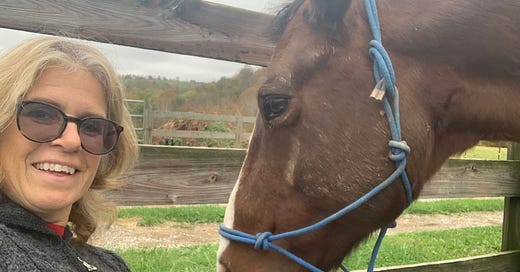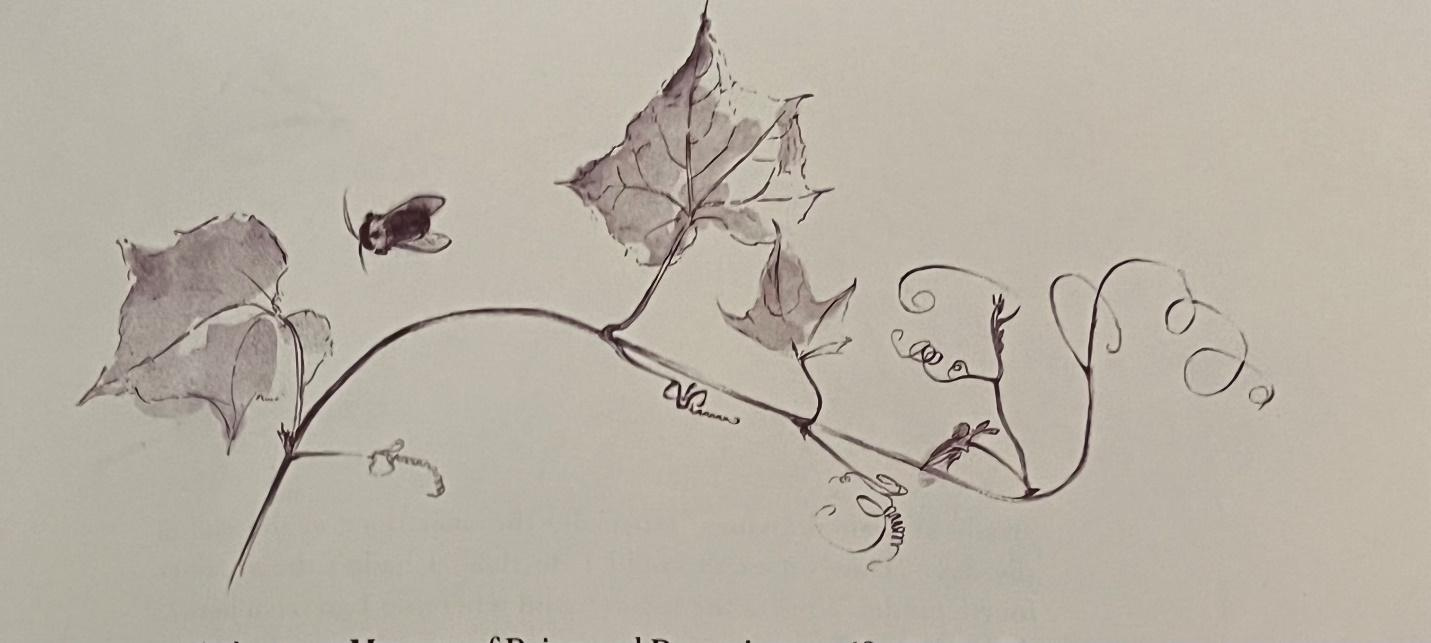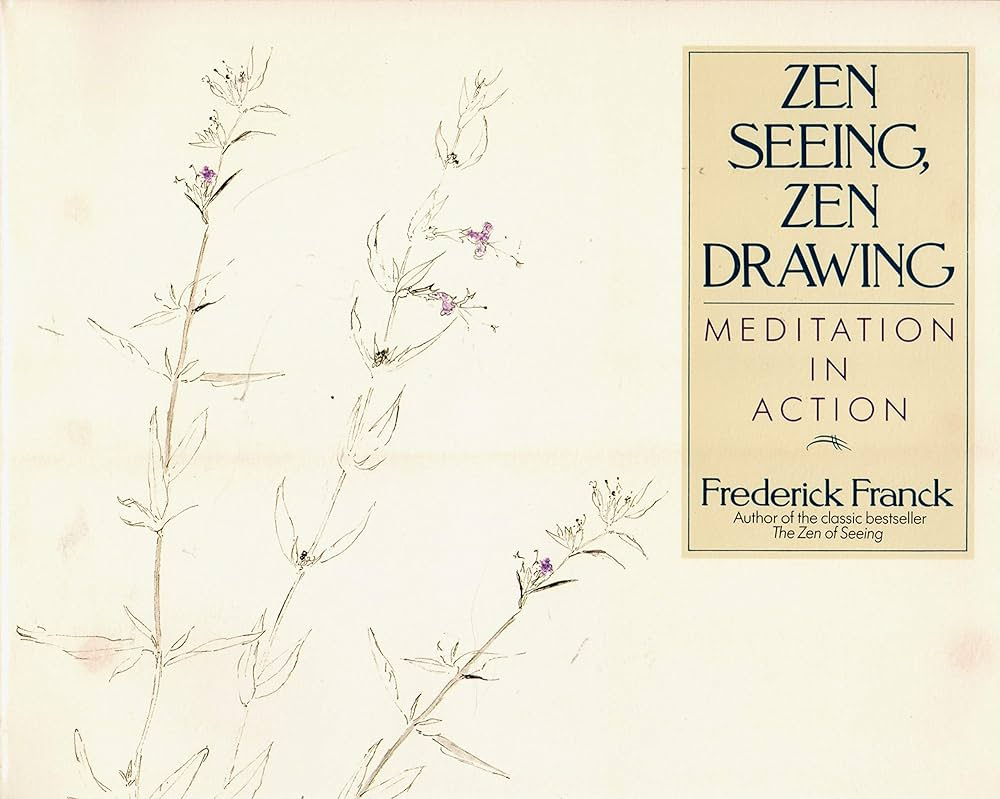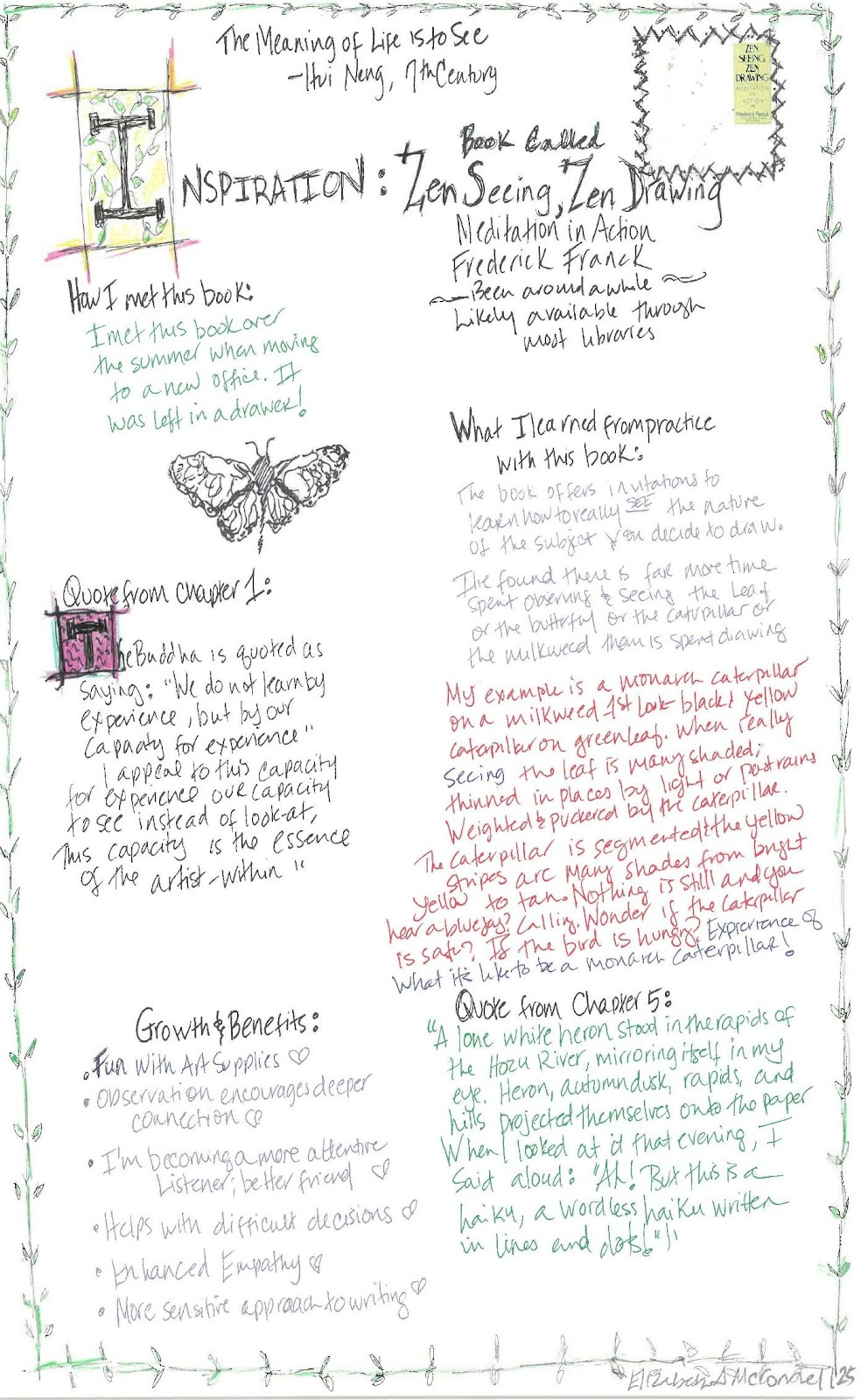On Zen Seeing, Zen Drawing Meditation in Action
an inspiration essay by poet and Master Naturalist Elizabeth McConnell 🍃
One of my favorite rituals in my Madwomen in the Attic writing workshops is the Inspiration of the Week, in which one writer is assigned to share a work of art—poem, prose excerpt, visual art, song, photograph, clip, anything really—that inspires them creatively. When it was Elizabeth McConnell’s time to share, she captivated all of us by telling us the story of how she met the book Zen Seeing, Zen Drawing Meditation in Action by Frederick Franck as though it were a meet cute in a love story. She then shared with us the profound experience she had putting this book’s wisdom into practice.
Elizabeth is a poet as well as a long-time member of our Be Where You Are community. She practices deep seeing and deep listening, and she brings this to her work as a Master Naturalist as well as to her writing, which is often rooted in the natural world and its wonders. I’m grateful to Elizabeth for sharing her powerful encounter with this book with us, and I not so secretly hope she will start a trend with other readers sharing their inspirations with us as well. 🍃
Elizabeth, on Zen Seeing, Zen Drawing Meditation in Action 🍃
How I Met this Book
Following the end of the school year, I was moving from one West Virginia University office to another, and during the move, discovered a worn copy of Zen Seeing, Zen Drawing Meditation in Action had been left behind in the side drawer of my new, but long-abandoned desk. I started flipping through, noticing some passages had been underlined – I read those first. This was a well-used book and I loved that.
I noticed each chapter offered both drawing advice as well as a sort of meditation, a quote, sometimes a haiku. I noticed contour drawings with simple lines and limited shading, but still engrossing and full of meaning. A co-worker, knowing my love for poetry and landscape saw the book on my desk, said she loved that book, said “Elizabeth, it’s a good one for you.” There was a name I recognized written on the inside cover, I tried reaching out, then later accepted ZSZD as a lucky gift. I took it out for lunch and began practicing the lessons.
When invited to talk about an inspiration in my Madwomen in the Attic workshop, I chose this book, new to me, but nearly my age, Zen Seeing, Zen Drawing Meditation in Action (ZSZD) by Frederick Franck. ZSZD was first published in 1973. There have been several editions released over the years; the one I practice with is a seemingly simple printed paperback teeming in ink drawings with just a slight few splashes of color. However subtle, these are powerful pieces, just flip to page 71 and you can feel the grape vine tendrils gentle sway with the current of air initiated by wings of the approaching bee.
ZSZD offers the artist the opportunity to practice drawing by paying intimate attention. The hand is guided by visualization. I’ve found these close observation techniques for drawing to be very helpful with many applications —art, writing, empathy, conversation, also travel, cooking, and gardening.
What I’ve Learned from this Book
ZSZD offers lessons and invitations for the artist to experience ways of deeply seeing the entire nature of the subject they decide to draw. A quote from chapter 1 reads:
“The Buddha is quoted as saying: ‘We do not learn by experience, but by our capacity for experience.’ I appeal to this capacity for experience, our capacity to see instead of look-at, this capacity is the essence of the artist-within.”
The first time I was consciously aware of how the lessons in the book had influenced my perceptions was in the Canaan Valley, WV during the late summer. I began following some ZSZD guidelines while sketching a monarch caterpillar on the underside of a milkweed leaf.
At first look – black and yellow, shiny caterpillar, green leaf, tall plant. But when I sat with it a bit and took the time to really see, an entire landscape unfolded. I noticed first the green leaf was many shaded, and textured. I noticed some leaves were thinned in places from maybe sun or hard rain. Noticed the leaf with the caterpillar was slightly weighted, puckered from the clinging caterpillar. The caterpillar itself was both supple and striped and the stripes were shiny, not just one shade of yellow and black, but bits of maize, bits of volt. I noticed this still life was not still.
In the near distance a bird called. Bluejay? I wondered whether the caterpillar was safe – had it been spotted? Was the bluejay even hunting? In those moments the experience transcended from caterpillar on plant to an entire scene from a Canaan Valley day, the plant in the sun, the bird nearby, the conditions that led to this experience.
In Chapter 12, Franck captures the essence of this ah-ha moment very well:
“A lone white heron stood in the rapids of the Hozu River, mirroring itself in my eye. Heron, autumn dusk, rapids, and hills projected themselves onto the paper. When I looked at it that evening, I said aloud: ‘Ah! But this is a haiku, a wordless haiku written in lines and dots!’”
Growth & Benefits
Observation brings deeper connection. Deeper connections encourage greater listening, greater empathy, closer and more meaningful relationships, as well as a more sensitive and inclusive approach to writing. I don’t know if I’ve become better artist, but certainly a more attentive one.
I would definitely recommend checking out, not just this book, but any lesson that invites you to lean into new views, and fresh perspectives. The abundant stream of surprises and deep joy we discover while being creative and exploring the world are among our greatest gifts.
Elizabeth McConnell is a poet and Master Naturalist from Morgantown, WV. Elizabeth earned a BA in English from Hollins University, Roanoke, VA. Previously she has worked at the Morgantown Public Library in Morgantown, WV and served on the Library Board of Trustees. Elizabeth is an active member of the Morgantown Writers Group, Monongahela Master Naturalists, and participates in the Carlow University Madwomen in the Attic Workshops. Her poetry has been published in Voices from the Attic, Volume 28, One Art: A journal of poetry, Northern Appalachia Review, and most recently, River & Stone, an anthology by the Morgantown Writers Group.
Have you read this book, and if so, what was your experience with it? If not, what books have you read that have profoundly changed the way you see, as this book did for Elizabeth? We’d love to know.
What You May Have Missed at Be Where You Are
The next Ass in Chair Collective meet-up this Sun, May 19th from 12-1 pm EST is FREE & open to anyone! Come join us to steal some creative time for you. Details/links in the post below 👇🏼
If you’d like to pitch an inspiration essay for Be Where You Are, you can just reply to this email. 📝 If you enjoyed this, will you take one moment to hit the LIKE button or leave a quick comment? This one simple action is incredibly effective at helping to spread the word about these interviews & what’s happening here at Be Where You Are 🌱 Be Where You Are is 100% reader-supported. You can support this work by becoming a paid subscriber for 5$ a month or make a one-time donation here if you value this work but can’t subscribe. Or, just send it to a friend! 🙏🏼🩵
Be Where You Are is a newsletter about how to use writing and mindfulness to live more fully where you are. To reply to this newsletter, just hit reply. I’d love to hear from you! I reply to every email I receive, although sometimes I’m slow! You can also find me on Instagram/Facebook/Bluesky or find more info at my website.












This book looks so pretty and sounds so peaceful. Thank you for sharing!
To truly look, see,
she pauses, ponders, proceeds.
Draw-ings in Zen then.